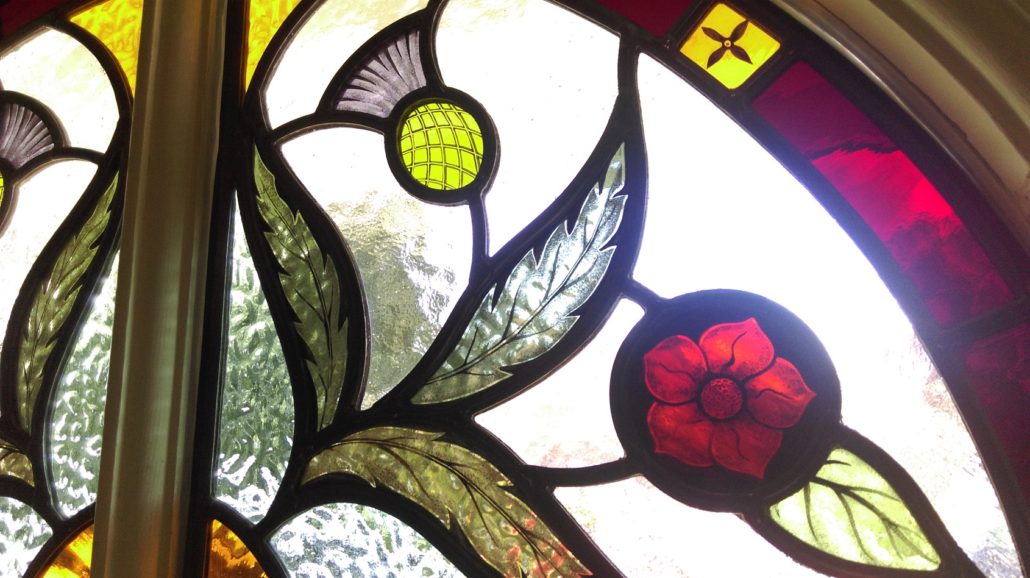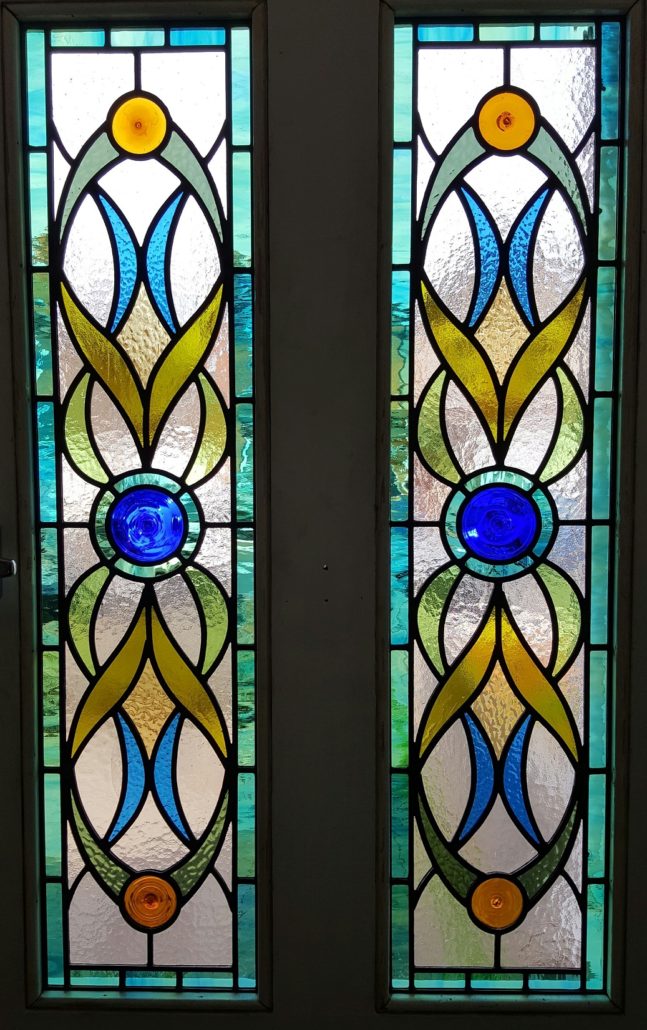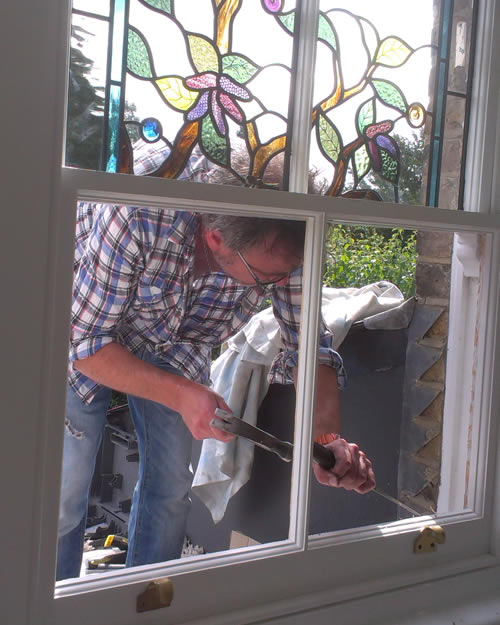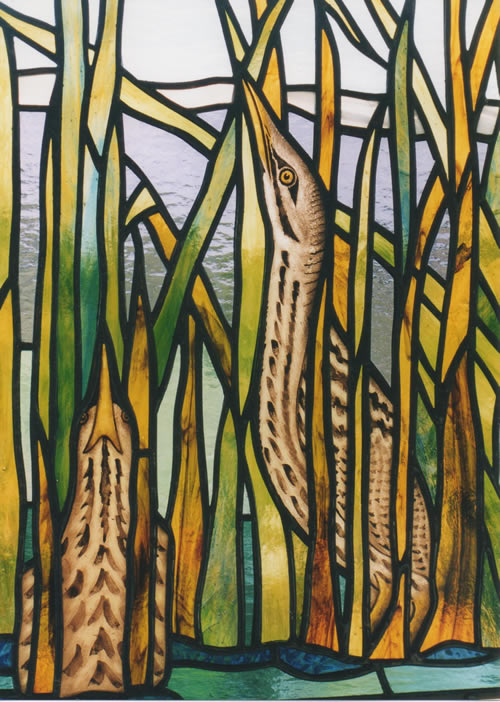


The first stage in commissioning a new piece of stained glass is for us to come and see where the window is going – its position, the amount of light coming through, how it will be glazed etc. Then, with the aid of photos and pattern books, we can talk to you about the type of design you would like and get a feel for what would suit your taste and the style of your house. Usually people leave the design process to us, however we are also happy to interpret the clients own ideas and artwork.
We then go away and come up with a design which is translated into a scale drawing. This is usually within one to two weeks. We then come back with the drawing and some glass samples showing the various colours and textures. All our stained glass panels and leaded lights are unique and custom made to suit the client’s requirements so this process is very important to us. If the design is approved the lead time is generally 6 weeks. However, this can vary depending on how urgently the glass is required – some clients have a tight schedule while others are in no hurry so jobs can be scheduled accordingly.
New stained glass panels and leaded lights can be fitted into a variety of areas. Usually we are asked to make stained glass for front door panels but we also do frontages, fanlights, transoms, skylights and landing windows. Sometimes a client just wants to match up with a neighbour’s design. Often in Victorian and Edwardian streets there would have been a set design throughout the road so it is nice to restore a door back to its former glory. Another popular use for stained glass is to disguise an unpleasant or nondescript view – a very boring view can be transformed into a real feature of the house. There are many applications for new stained glass panels.



When a window is in need of restoration we carefully de-glaze the panel and temporary glaze the aperture with a piece of textured glass (for privacy and to make safe). We then bring the window back to our workshop for repair. If the window is very badly bowed, there are many broken pieces or the lead has deteriorated it is likely that the panel will need to be re-leaded.
A rubbing is taken so that the window can be taken apart and easily put back together again. We then cut all the solder joints and gently dismantle the panel. All existing glass is kept where possible and any broken pieces replaced with matching or similar glass. We sometimes have old pieces of glass left over from previous or unwanted windows which can be recycled.
The window is then re-built using new lead and, as with all stained glass panels, soldered, cemented with leaded light cement and polished. The window is then ready to be installed.

Our glazier has over 25 years experience and can glaze the simplest of door panels to the most intricate of church panels. However, if the client wishes to install the panel themselves we are more than happy to provide a supply only service.
Double Glazing – We are often asked if we can fit stained glass and leaded lights into double glazed units, in effect ‘triple glazing’. This is a service that we offer, however, we cannot provide a guarantee for the windows as you would receive with a standard double glazed unit. This is because the stained glass acts as a ‘foreign body’ inside the unit.

If the lead is in good condition but there are a few breaks throughout the panel, as long as they are not all in one place it is often possible to carry out these repairs on-site or ‘in-situ’. We like to call these ‘invisible repairs’ as it is one of Michael’s specialities! He actually honed his skills whilst working on the restoration of York Minster in the late 1980s.
The old glass is removed and the lead very carefully bent back to its heart. A new piece of glass is then cut and inserted into the space. The lead is then bent back into place and, lastly, the edges are filled with leaded light cement to add strength and to waterproof. This is a great, hassle free way of repairing broken stained glass, however, if the broken pieces are adjacent to one another or the surrounding solder joints are cracked it is not recommended.



This is originally what stained glass was all about. The silver stain (Silver Nitrate) is what is applied to the glass to give it its distinctive yellow/amber colouration and it is this ‘stain’ which gives stained glass it’s name. This combined with the wonderful trace lines and shading techniques used by Medieval craftsmen can be seen in cathedrals and churches throughout Britain.
During the Victorian era this painting and staining was used to great advantage to create some wonderful pieces and it is this style that we are often asked to recreate today. We use traditional kiln fired paints, stains and enamels to emulate these effects particularly in the Victorians’ favourite subjects of flowers, fruit and birds roundels. The addition of glass painting can give stained glass commissions that authentic feel that really adds to a traditional period piece.
However, these ancient techniques can also be used in contemporary pieces to great effect, adding depth and shade to all manner of abstract designs.
